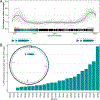The prototypic crAssphage is a linear phage-plasmid
- PMID: 40730160
- PMCID: PMC12358190
- DOI: 10.1016/j.chom.2025.07.004
The prototypic crAssphage is a linear phage-plasmid
Abstract
The prototypic crAssphage (Carjivirus communis) is an abundant, prevalent, and persistent human gut bacteriophage, yet it remains uncultured and its lifestyle uncharacterized. C. communis does not readily plaque, suggesting a largely non-lytic lifestyle. Here, we find that C. communis is a linear phage-plasmid that stably persists extrachromosomally within its host. Plasmid and phage-related genes are transcribed, and multiple putative replication origins may initiate replication for multiple lifestyles and genome conformations, including both circular and linear formations. Leveraging these findings, we use a plaque-free culturing approach to measure C. communis replication on prevalent gut bacteria, notably Phocaeicola vulgatus, P. dorei, and Bacteroides stercoris, revealing a broad host range. C. communis persists without causing major cell lysis events or integrating into host chromosomes. Taken together, C. communis' ability to switch between phage and plasmid lifestyles within a wide range of hosts may contribute to its widespread presence in human gut microbiomes.
Keywords: Bacteroidota; Carjivirus communis; Phocaeicola; bacteriophage; crAssphage; microbial genomics; microbiome; phage culturing; phage-plasmid; plasmid.
Copyright © 2025 Elsevier Inc. All rights reserved.
Conflict of interest statement
Declaration of interests I.L. is an employee and shareholder of Phase Genomics, Inc., which commercializes proximity-ligation technology.
Figures







References
-
- Dutilh BE, Cassman N, McNair K, Sanchez SE, Silva GGZ, Boling L, Barr JJ, Speth DR, Seguritan V, Aziz RK, Felts B, Dinsdale EA, Mokili JL, & Edwards RA (2014). A highly abundant bacteriophage discovered in the unknown sequences of human faecal metagenomes. Nature Communications, 5(1), 4498. 10.1038/ncomms5498 - DOI - PMC - PubMed
MeSH terms
Substances
Grants and funding
LinkOut - more resources
Full Text Sources

